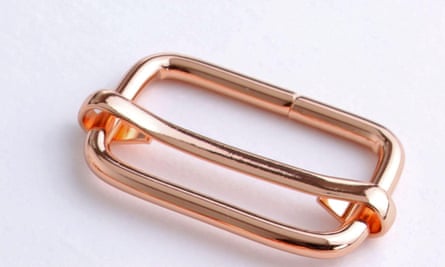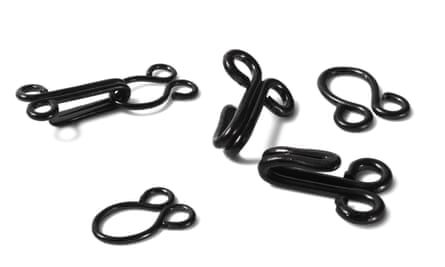
There are few things more annoying than going to put on an outfit and discovering something crucial has been lost: a belt that leaves behind empty loops on a coat; the matching tie that gave a dress a waist; a broken fastening that once held a pair of trousers’ fly shut.
Although small, the absence of each can make a garment less satisfying (or even decent) to wear.
But all you really need is creativity and a little bit of motivation to remedy these missing pieces, freeing clothes from that corner of the wardrobe dedicated to things we don’t use but feel weird about throwing away.
Missing dress ties
Just because a dress came with a tie or belt, it doesn’t mean it needs to be cinched if they are lost. Start by considering whether a belt is required at all, says Julia English, a repair advocate and host of the podcast Seam Change.
“If you like how it looks without the belt, remove the evidence! Unpick belt loops or trim off the thread loops that hold it in place.”
If you want to have the option of wearing a belt or tie, there are a few solutions. The most obvious is to find something else in your wardrobe that works – like a belt or tie from a different dress.
“A simple leather belt in black or a neutral tone can be worn across many outfits,” says Holly Simpson, the founder of repair service Hot Dog Workshop. Alternatively, English suggests searching for some fabric or a heavy-weight ribbon. You can even make ribbon stiffer by stitching two layers together.
Replacement buckles can be found online or through haberdashery stores. “Look for the ones that look like an oval with a bar through the middle,” Simpson says. “These use friction to hold the belt together rather than eyelets or holes. This means it’s simpler to do yourself.”
If you really need it to match, a more involved alternative is to graft a new tie from the skirt’s hem. Simpson recommends first looking at the hem allowance (the amount of fabric folded up under the bottom of the skirt). “If that is around 5cm or more, you will be able to take the fabric from here without altering the original look of the garment.”
If the skirt doesn’t have a large allowance, you will have to shorten the hemline. But Simpson cautions this can be complicated and might alter the proportions of the dress. Unless you are confident in your skills, employ a professional seamstress or tailor to do it for you.
Lost coat belts
If a belt was necessary for keeping a coat closed, replacing it with some kind of fastening is integral – otherwise it won’t keep you warm. “A quick solution is to purchase an oversized metal safety pin,” English says. “This can hold your jacket closed and maintain a minimalist aesthetic.”
If you’re more of a maximalist, she recommends reaching for a large brooch.

Alternatively, Simpson says you can make a belt replacement with another piece of fabric or cord. She also suggests adding buttons to keep the belt in place. “Wrap it around you to the fit you feel comfortable in and mark out some placements for the buttons and buttonholes or loops to secure, choose your buttons and off you go.”
While the buttons might be simple enough for an amateur sewer to attach, button holes can require more skill, especially on thick material. Make some inquiries with a tailor to see if this is something they can assist you with.
While you’re there, you could also ask about the possibility of recreating the belt using fabric from elsewhere in the coat, such as the hem or the lapel. “Coats often have complex hems to allow for linings and facings,” English says. “This might be a good chance to support a local alterations specialist, if you have your heart set on regaining a matching belt.”
Otherwise, depending on the brand, you might be able to contact the coat’s manufacturer for a replacement. An increasing number of fashion companies now offer repairs or replacement parts – and they may not even charge you for it.
Slipped cords

If the cord has fallen out of your tracksuit pants or hood and vanished, Simpson says depending on how long it was, “a shoelace could do the trick”. Alternatively, you might need to take a trip to a haberdashery to source some cord in the right length and colour to match or compliment the garment.
Gemma Metheringham, a former creative director turned circularity expert, says once you’ve found your replacement “the trick is to put a safety pin through one end of the cord and gently push it back safety pin first”. Don’t forget to secure the cord with a knot, or you risk losing it again.
Torn off toggles
If the toggle has gone missing from the end of an elastic or cord, don’t panic. “Toggles are surprisingly easy (if fiddly) to replace,” English says. “You can find them at haberdashery shops – or on old sleeping bags.” For a perfect match Simpson recommends searching online.
To put a toggle back on your garment, it helps to understand how they operate. “Toggles work by passing the cord through an inner and an outer component. These have aligned cylindrical holes. When the toggle is released, the spring pushes on the inner section so that the hole no longer aligns, gripping the cord that runs between in the process,” English says. “To replace, press on the toggle to align the holes, pass the cord through, and knot.”
Unfastened trousers
Broken trouser hooks are one of the easiest problems to fix, Simpson says, and “an opportunity for you to practise hand sewing”.

Depending on the trousers, the fastening may require either a hook and eye, or a bar and eye, which is a larger, sturdier fastening. Simpson says both can be bought at haberdashery stores and packets of them make useful additions to your at-home repair kit.
“All that needs to be done is to make a few secure stitches to the garment then add the hook and eye to the position,” Simpson says. “[Add] a couple more stitches through the metal loops [then] make a neat knot to secure, trim threads and you’ve got yourself hooked in.”
Do you have a fashion emergency you’d like closet clinic’s help to solve? Email [email protected] with questions or suggestions for future columns.



